Battling Bermudagrass
Here are the positive aspects of bermudagrass: it makes a decent lawn in this area. While it dies back in the winter it is amazingly hardy about reviving in the spring, it is drought tolerant, its dense carpet handles heavy foot traffic, it does not need much in the way of watering once the monsoon season hits with full force, and it makes a good livestock feed provided their uncomposted manure is not used as fertilizer.
However, bermudagrass also has a down side. It is extremely difficult to eradicate, and spreads very easily to areas where it is unwelcome, such as gardens. Bermudagrass seeds survive the digestion process of livestock and so using uncomposted manure of bermuda fed livestock will most likely result in a serious infestation. Bermuda propagates both via seed and extensive underground root systems. I swear it can penetrate concrete. It can establish itself in the tiny cracks between concrete, sending down roots that are nearly impossible to destroy.Some people suffer severely from allergies to bermudagrass pollen.
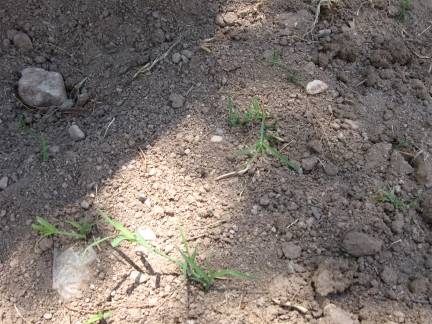
|
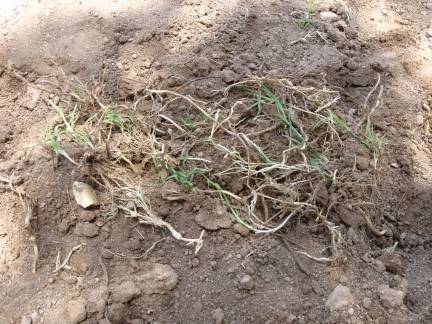
|
| What appears above the ground... | and the dug up root system lurking below the ground |
Bermudagrass can form a dense carpet of vegetation. The grass in the picture below is just starting to fill in following late spring rains.Bermudagrass flowers have three or more soft spikes that produce pollen and then release seeds that are easily blown and scattered.
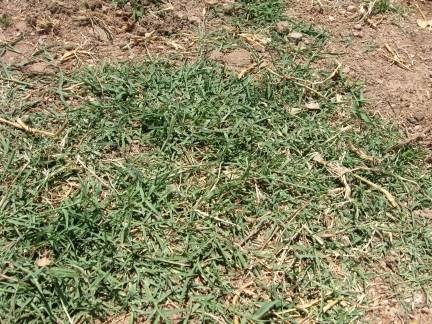
|
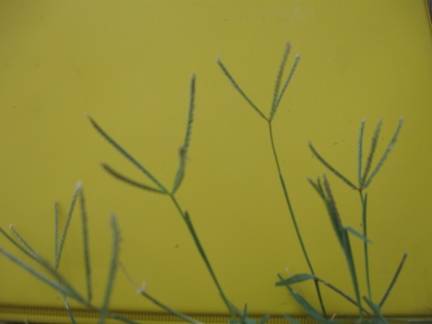
|
| Bermudagrass awaiting execution | Prodigious bermuda flowers resemble birds feet |
Some of the reasons that make bermudagrass annihilation difficult is that it spreads through rhizomes (root segments capable of generating new plant growth), stolons (above ground shoots capable of rooting) and through seed which can remain dormant and viable in soil for two years. Bermudagrass has an extensive root system with rhizomes that can regrow vegetation when even a small segment of root is accidently left in the ground after weeding.
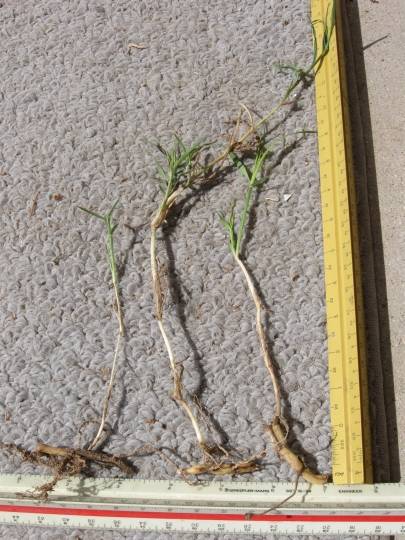
Small pieces of root are capable of growing up through six inches of soil to produce new plants. Even after extensive weeding, turning the soil to to shovel depth, and picking out all visible roots, I revisit my garden on a daily basis to dig out a multitude of fresh shoots.
The areas where I planted tomato and pepper starts were dug to a depth of one foot and raked through to remove as much bermuda plants and roots as possible so as to avoid disturbing the new plant roots with deep weeding.
In this picture I am showing just a few of today's diggings to illustrate the tiny section of left behind roots barely an inch in length.The white area of the bermudagrass plant shows that it had to grow up through at least five inches of soil to reach the surface.
Rulers to the right and bottom are shown for size comparison.
A comprehensive article on bermudagrass eradication: http://www.ipm.ucdavis.edu/ PMG/PESTNOTES/pn7453.html
The main difference between southern Arizona and California is that the majority of our rainfall occurs in the summer months, so some methods mentioned are not applicable. Also, I prefer to not use chemical methods. I have a friend who had a dog that was partially blinded by a neighbor's application of a chemical herbicide, and, of course their use is contraindicated in a garden.
In an area that was previously a bermudagrass lawn, I started my garden nearly three months ago and am still waging war against the bermudagrass. Following daily skirmishes armed with a hoe and shovel, there is currently less bermudagrass in the front yard than what I started out with, so I am entertaining the possibility that I am winning the war; however the monsoon season has just begun, and hopefully I am not mistaken in my presumption of victory.
After weed and root removal, to prevent the bermudagrass from taking root in the compost pile I roast it thoroughly for a few days in the direct blazing Arizona sunlight. Then I gather it up and dry it longer in black plastic flower pots that get quite warm in the sun, just to be sure it is completely dead with no chance of revival. After that, the dead grass is placed on our bermudagrass compost pile.
We have a sizeable pile this year since former tenants have not maintained the yard. We are allowing the pile to dry further, then will begin the composting process of layering, adding water, and using a pitchfork to rotate and aerate the pile as it heats up. It is my understanding that a properly heated compost pile will reach temperatures in excess of 140 degrees Fahrenheit, thus ensuring the demise of bermudagrass rhizomes, seeds, and vegetation. An informative link on bermudagrass composting both failed methodology and suggestions: http://www.dirtdoctor.com/newforum/root/will-hot-composting-kill-bermuda-grass-t4645.html
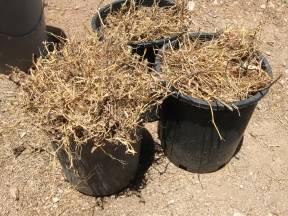
|
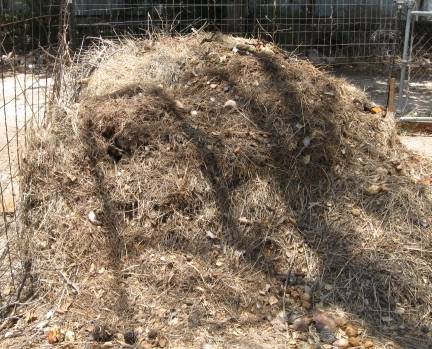
|
| Kill the bermudagrass in the sun before composting | 6'x6'x3' Bermudagrass compost pile |
Anyway, this is the method I am trying. If you have something that has worked for you, please feel free to post an article on the method you have used. As for me, I will never plant another bermudagrass lawn. I am researching the use of native grasses instead. If anyone has any suggestions for a small, low water usage lawn I would greatly appreciate hearing them. I would like a small grassy area for playing lawn games, walking barefoot, and a place to occasionally put up a slip'n'slide for my grandkids.
Native grass lawn link:
A list of Arizona native grasses:
http://ag.arizona.edu/yavapai/anr/hort/byg/archive/selectingnativegrasses2009.html